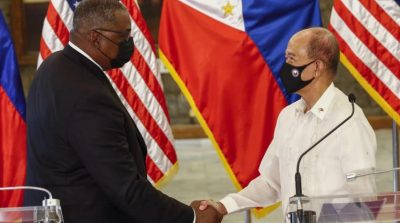US Hopes to Turn Philippines into Military Outpost Aimed Against China

All Global Research articles can be read in 51 languages by activating the “Translate Website” drop down menu on the top banner of our home page (Desktop version).
Visit and follow us on Instagram at @crg_globalresearch.
***
On July 29, Filipino President Rodrigo Duterte decided to cancel his plans to end the Visiting Forces Agreement (VFA) – an important defense treaty with the United States. He said that the legal conditions for the temporary U.S. military presence in the Philippines has existed since 1998, on which the two sides conducted joint exercises on land, air and sea. Duterte informed Washington of his intention to cancel the agreement in February 2020, but withdrew the decision at a meeting with U.S. Defense Secretary Lloyd Austin in the Filipino capital of Manila on Friday.
“There is no request to terminate the VFA pending and we are back on track,” Philippine Defense Secretary Delfin Lorenzana told reporters.
The head of the Pentagon welcomed Duterte’s decision, which as he said, would help strengthen defense ties between the two countries. Austin said that it gives confidence in the future of their bilateral relations, especially now that the U.S. can make long-term plans for the Asia-Pacific region and conduct a variety of training activities aimed at containing China.
Several other defense agreements between the Philippines and the U.S. are contingent on the VFA. For Washington, the VFA agreement is strategically important because it provides the legal framework for the movement of thousands of American troops to the Philippines as part of their pressure campaign against China in the region.
Amidst rising tensions with China over the Taiwan issue, it was important for the U.S. to uphold the deal with the Philippines, an archipelago of 7,640 islands. The Philippines is all the more crucial for U.S. strategic planning as it is located just south of Taiwan, an island that Beijing considers a rebel province. If Washington loses leverage over Taiwan to exert military pressure, it means that they will fail in their pursuit to dominate the Asia-Pacific region. Washington wants to enlist the support of the Philippines and other partners in the region to maintain and strengthen its ability to confront China, the U.S.’ main economic adversary in the 21st century.
Almost all of the top generals in the Filipino military have trained in the U.S. The Filipino military is focused on developing their relations with the U.S., which is one of the most important conditions for consolidating the military’s power and influence in civil society. Therefore, Duterte’s decision is a compromise with the military’s elite ahead of the 2022 presidential election.
According to the Philippine constitution, a person who is elected president cannot be re-elected after the end of their 6-year term. The current president cannot be re-elected in 2022, but most local observers point out that his daughter, Sara Duterte, is a leading candidate to succeed him.
Interestingly however, the day Duterte held talks with the U.S. Secretary of Defense, he attended the inauguration ceremony of a bridge project connecting Makati and Mandaluyong cities. The bridge, built with Chinese financial support, is expected to reduce congestion on major highways in Greater Manila and should contribute to the economic development of the metropolitan area.
Perhaps it is no coincidence that the bridge opening ceremony coincided with the meeting between the Philippine President and Austin. Manila could be showing that despite continuing with VFA, it wants to maintain a balance with Washington and Beijing.
The U.S. traditionally forces its partners in the region to make a choice – the U.S. or China. This vector was particularly pursued under the previous Trump administration. President Joe Biden still implements this policy, although not as openly or publicly aggressive compared to his predecessor.
Southeast Asian countries generally want to have independent policies that do not force them into the American or Chinese orbits. However, historical animosities are in fact pushing some countries, such as Vietnam, to lean more towards the U.S. rather than China. However, even Vietnam cannot completely divorce from China as it is an irreplaceable export-import partner. Vietnamese exports to China were worth $48.88 billion in 2020 and Filipino exports to China were worth $9.81 Billion in 2019.
In the midst of a global health crisis, breaking or damaging relationships with an important economic partner is unwise, just as Brazil’s Jair Bolsonaro had to learn the hard way. Therefore, it is very likely that by taking this step, Duterte wants to show that the Philippines has its own interest in ensuring security and developing the country’s economy with the support of China, but without breaking military ties with the U.S.
Speaking at the opening ceremony of the bridge, the Philippine President thanked the Chinese leadership for funding the construction and called the project a demonstration of the goodwill of the Chinese people and government.
Under this context, it appears that Duterte is not prepared to make his military truly independent from Washington. At the same time, the Philippines acknowledges that its development is hinged on its economic cooperation with China. Manila is now trying to find a balance without being consumed by either major power.
*
Note to readers: Please click the share buttons above or below. Follow us on Instagram, @crg_globalresearch. Forward this article to your email lists. Crosspost on your blog site, internet forums. etc.
Paul Antonopoulos is an independent geopolitical analyst.
Featured image is from InfoBrics

